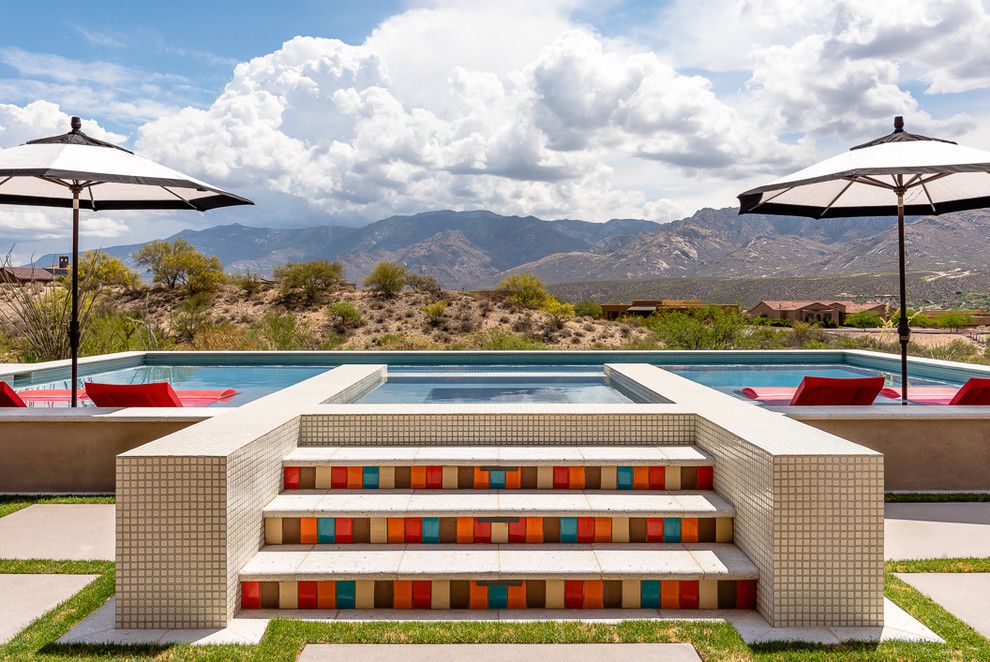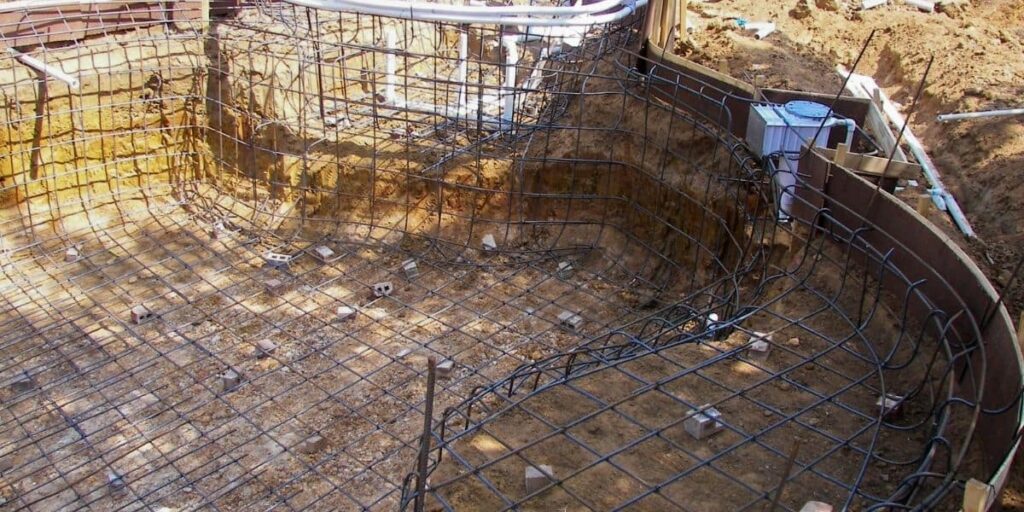A high-quality swimming pool is a great addition to any backyard. From pool parties to lazy days lounging poolside to the potential for an increase in home value, there are many reasons for homes in sunny Florida to have a pool installed.
What makes Florida an ideal place for a pool? Known as the Sunshine State, Florida has a warm, consistent climate that is practically begging you to take a swim any time of year!
Plus, many Florida homes either already have or are designed to support a pool cage, providing the perfect built-in location where a pool can be installed.
From small to large and everything in between, Latham has pools of every size and shape to fit your lanai or pool cage comfortably! Even if you have an existing pool cage or lanai, giving your fiberglass or vinyl liner pool a makeover can be done with minimal hassle. Simply, replace a liner or install a fiberglass shell to refresh your poolside paradise!
You may have heard myths that Florida’s heat is just too intense for fiberglass or vinyl liner pools — but that couldn’t be further from the truth. With proper care and maintenance, a swimming pool can be a durable (and refreshing) addition to your home that the whole family will enjoy, season after season.
Read on to learn everything you need to know about designing and building a vinyl or fiberglass pool in Florida, including topics like how to maintain your pool properly, which construction materials you should choose for your pool, some of the most popular pool designs and features that are available in Florida, and more. And if you still have questions, our friendly team of experts is just a click or call away!
Fiberglass Pools in Florida
Considering a fiberglass swimming pool for your Florida home? We’ve covered all the basics you need to know before you dive in. Keep reading to learn about some popular Florida pool designs, the process of replacing or upgrading your current pool, and important Florida pool regulations that will impact your project, along with a few points about seasonality and fiberglass pool maintenance.
Florida Pool Designs
Pools can be designed in a huge range of shapes and sizes. Here are four of the most popular pool styles in Florida — with countless ways to customize each one!
- Rectangular – If you like bold, clean lines or just want a traditional look, a rectangular pool is a great option. Whether you want to go big, or just need enough space to get your morning laps in, a rectangular shaped pool is ideal. Some examples of rectangular-shaped pools include classic linear, Roman pools and such models as:
- Olympia 12 – Timeless design and built-in swim-up seating makes this rectangular model an inviting and relaxing option.
- Astoria – With swim-up seating,multiple entries and exits, a wading area that’s great for kids and a built-in spa, the Astoria model has it all!
- Claremont– Make a splash with a simple-yet-elegant rectangular shaped pool that’s both autocover-ready and easy on the eyes thanks to breathtaking Crystite color technology. Enjoy a cool dip in this rectangular-shaped pool, equipped with swim-up seating and slip-resistant steps.
- Freeform – Freeform pools are an attractive alternative to rectangular designs, especially if you want a natural-looking pool that will seamlessly blend with the curves and lines of your landscape. Plus, you can get creative with freeform designs and they work beautifully with smaller outdoor spaces. Explore a wide variety of freeform models, including:
- Key West – Stylish with graceful curves and classic freeform styling, the Key West has slip-resitant steps tucked into the corner, swim-up seating and can be equipped with a number of features to suit your fancy.
- Cancun – If you’re looking for a thoroughly modern freeform pool, try the Cancun on for size! Curved, slip-resistant steps and swim-up seating offer a variety of relaxing spots alongside plenty of space to splash!
- Rockport – With its unique curves-meet-geometric angles shape, the Rockport is a traditional freeform pool that bucks convention. It features slip-resistant “wedding cake” steps and ample seating to make your pool the place to be!
- Plunge – Think your yard or lanai is too small for a pool? Think again! Cute, compact, and easy to clean, the plunge pool is a space-saving solution for homeowners who just want a practical way to lounge and cool down — without the hassle of full-size pool maintenance.
- Milan – For an outstanding example of one of these “fun size” pools, check out our Milan model, which boasts a 4’ depth, swim-up seating for enjoying a cold beverage while partially submerged and slip-resistant steps for a safe entry and exit.
- Kidney – Balancing the classical with the whimsical, kidney pools give a playful touch to the classic round or oval design. Check out some of our favorite picks for kidney-shaped pools, including:
- Valencia – With generous ledging to sit and Crystite color technology for a simply striking look, the Valencia is as gorgeous as it is roomy. Perfect for swimming laps or entertaining poolside!
- St. Lucia – With tiered wedding cake steps and swim-up seating, St. Lucia is a versatile kidney-shaped pool, whether you’re looking for an inviting place for the kids to play, or a watery sanctuary to soak.
- Jamaica – With its sleek, timeless design and swim-up seating, our Jamaica model offers you a slice of paradise to enjoy in your own backyard.
Choosing a shape and size is only part of the overall pool design process. Why not customize your pool further with gorgeous and functional add-ons? Here are three ways to add design flair and truly make it your own.
- Water Features – Whether you imagine a tropical jungle oasis, a serene Zen-inspired water garden, or the glitz and glamor of fountains in Las Vegas, water features are the perfect way to express yourself and add personality to your pool.
- Lights – Lights make it safer to swim in the evening while simultaneously adding to the ambiance. From a subtle glow to fun party lights, lighting lets you control the mood, look, and feel for a new experience every time you swim.
- Tanning Ledges – Now you can work on your tan while you work from home! After all, Florida is known as the Sunshine State. Take advantage and soak up the rays on a comfortable, sturdy, and spacious tanning ledge.
The best part is that your pool can be infinitely customizable. Choose any pool shape, size, and features you like, as long as you stay within state and local regulations and work with the layout of your property!
It’s also worth mentioning that different shapes and designs might work better, or be more popular, in different areas of Florida. If you’re curious about the best-selling and hottest designs in your location, contact our builders and we’ll be happy to guide you through the most popular local options.
Transforming or Replacing You Current Pool
Gunite (or concrete) was a popular pool construction material during the twentieth century. Whether you’ve chosen a concrete pool or inherited one as part of a new home you’ve purchased, over time, these types of pools can become rough on the skin. Concrete pools can also feel a little chalky after many years of use and not as smooth-to-the-touch as a fiberglass pool. While an older concrete pool can be resurfaced, the process can be quite expensive, ranging between $10,000 and $20,000.
While gunite remains popular today, there are often more economical options available that offer equal longevity and involve less maintenance. For example, if you have an old gunite pool which is damaged or needs to be replaced, you can save money by choosing fiberglass instead of fresh gunite as the replacement material. Fiberglass is exceptionally durable and can be installed in the same hole as the original gunite pool, where — with proper care and maintenance — it can last for 25 to 30 years, or potentially longer.
Florida Pool Regulations
It’s important to be aware of — and comply with — state and local regulations when planning and building a swimming pool in Florida. This includes regulations around drainage, retaining walls or safety features. For example, if you intend to build on a slope, you should know that under Chapter 18 of the Florida Building Code (1805.3.3), “[The] portion of the pool wall within a horizontal distance of 7 feet (2134 mm) from the top of the slope shall be capable of supporting the water in the pool without soil support” — one of the many regulations an experienced builder can help you interpret and follow.
However, it’s important to keep in mind that rules and regulations around pool safety and maintenance change frequently. While the information offered here serves as a helpful guideline, be sure to do your homework and double check your state and local regulations to be sure your pool is compliant.
Here are a few of the most common questions we hear about the regulations that affect the pool design and construction process in Florida:
- What is the maximum pool depth for a residential pool in Florida? Most Florida regulations limit this depth to eight feet, though exceptions may apply in some areas.
- How far does a residential pool have to be from a building, like your house? Rules for this distance, called the “setback,” can vary from one municipality to the next. For example, in Jupiter, FL, under Sec. 27-3084, “Setbacks for a pool or spas as an accessory use to a single-family dwelling shall be a minimum of 10 ½ feet on the rear and interior sides, 28 feet on the front, and 18 feet on the corner side, unless a greater easement width exists, in which case the width of the easement shall be the minimum setback” — not exactly a straightforward set of measurements. Fortunately, our builders are here to help ensure you get an accurate reading and comply with the rules that apply in your location.
- Are fences required around a pool or backyard in Florida? Under Florida’s Residential Swimming Pool Safety Act, specifically Section 515.27(1), “In order to pass final inspection and receive a certificate of completion, a residential swimming pool must meet at least one of the following requirements relating to pool safety features.” The code then provides a list of features that pool owners can choose from, with one possibility being that the pool is “isolated from access to a home by an enclosure,” i.e. safety fence, “that meets the pool barrier requirements [applicable under the code].” In short, a fence is one of various options you could use to satisfy Florida’s pool safety requirements.
- Are pool covers required in Florida, and if so, what kind? The same information about fencing applies to pool covers in Florida: though not strictly mandatory, they are one of various potential options to fulfill Florida’s broader pool safety standards, as you can see listed at Section 515.27(1)(b) (“The pool must be equipped with an approved safety pool cover”). As an added bonus, pool covers also help keep pests, twigs, seeds, and other items out of your pool water — even if a curious insect or wind-blown leaf happens to find its way inside your lanai.
It’s also important to remember that different towns or even neighborhoods can enforce their own regulations. Your expert Latham builder will help coordinate with local officials to ensure that zoning and permitting issues are all handled properly throughout every stage of your project, providing you with total peace of mind.
Florida Seasonality
Florida’s hot and sunny climate provides fantastic “pool weather” practically all year long! That means you get more for your money with the ability to enjoy your pool for the majority of the year, unlike some colder states where swimming is only possible during a short summer season.
Even when the weather gets a little too chilly for swimming, the pool still provides a great focal point for barbecues, backyard hang-outs, get-togethers around a firepit, or sharing a peaceful morning coffee on the lanai. When weather turns a bit brisk, an attached spillover spa can be a welcome addition, giving you a spot to relax in warmer water – or to ease sore muscles any time of year. From Miami to Jacksonville and everywhere in between, Florida offers the ideal environment for getting a tan, taking a dip, or just enjoying the breeze — maybe while you catch a glimpse of some of the state’s fantastic wildlife!
During the off-season, such as January and February, you may wish to consider utilizing a pool heater and/or cover, which a builder can advise you on. Using a pool cover will also help prevent issues like algae, cloudiness, and scum from developing in the water during extended periods of non-use, such as any time you go away on vacation. Additionally, an automatic pool cover can help protect your pool during heavy rain seasons, keeping your pool’s water levels and chemistry at the right levels. Provided there are no large holes or tears in the screen, your pool cage or lanai will also offer an added layer of protection.
Maintenance
Fiberglass pools are prized for their comparatively minimal maintenance requirements — among the many other great benefits and advantages they offer! However, you’ll still need to take a few steps to help ensure that your fiberglass pool stays fresh, clean, and inviting. Here are some key points to know about fiberglass pool maintenance in Florida:
- Cleaning — Whenever cleaning your pool, be sure to use only products that are specifically designed for use on fiberglass. Our builders are happy to recommend a wide range of brands, accessories, and equipment to keep your pool clean, such as vacuums, filtration systems, and more.
- Chemistry — Whether your pool is fiberglass or vinyl, you’ll need to learn how to maintain its chemistry to ensure that the water stays fresh, clean, and safe for swimmers to enjoy.
- Covers — Pool covers pull double-duty, blocking leaves and other debris while — more importantly — preventing unsupervised usage and accidents. Covers can also help lock in heat and save you money on energy.
- Algae — Algae can develop if your pool water is not balanced and cleaned properly, speaking to the importance of pool chemistry. If you’re already dealing with an algae problem, speak to a pool builder about the best products to use to get the growth under control fast.
- Protection — Along with using a cover, you may want to consider taking some additional measures to protect your pool against common pollutants like sunscreen, which can build up and interfere with filtration systems over time. For example, you may want to consider applying an enzymatic solution. If you have any questions about when to apply it, how much to use, or whether there are alternative options, contact our builders and we’ll be happy to assist you!







